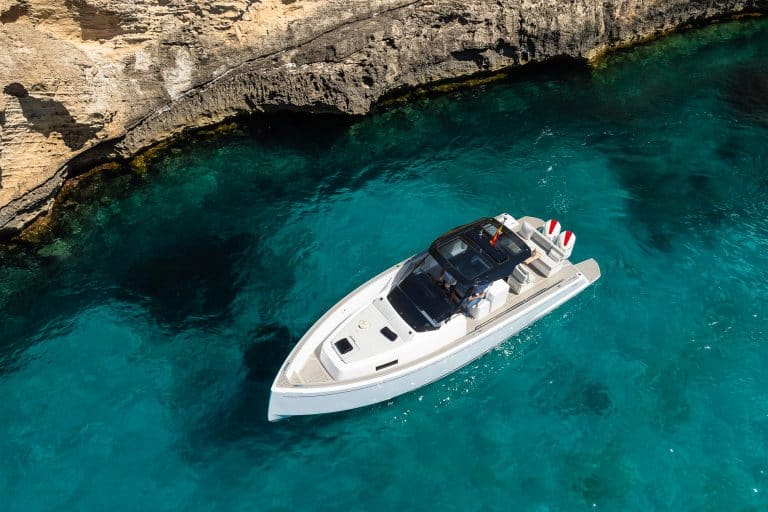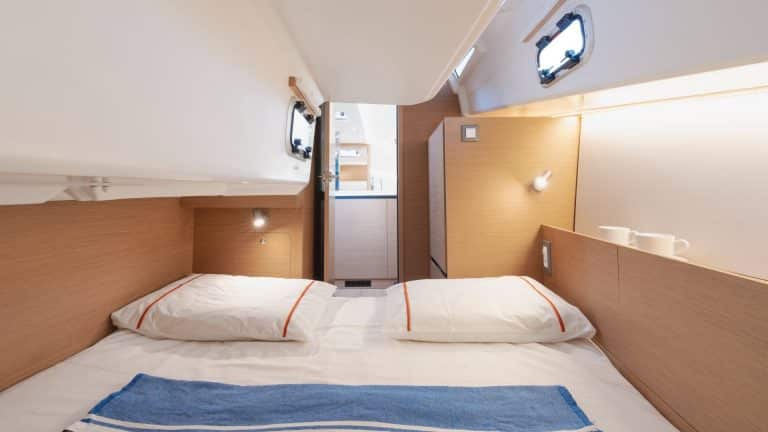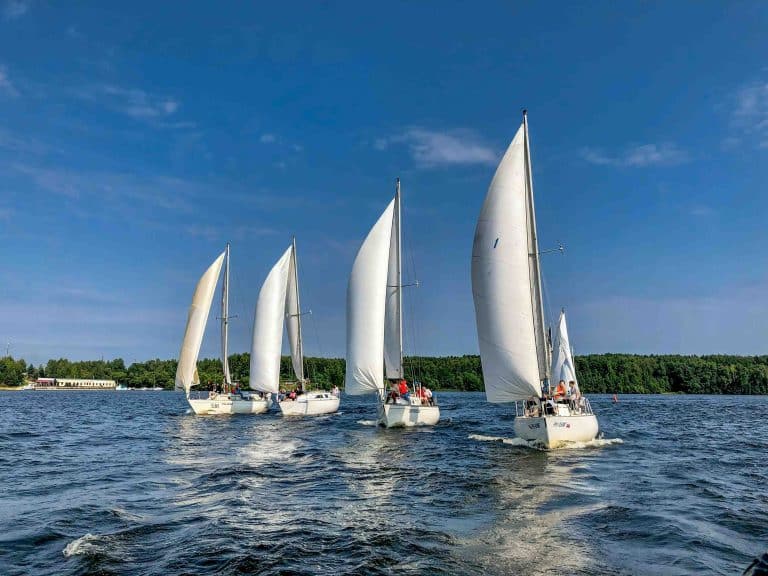Are you passionate about the idea of sailing the seas and exploring new horizons? Do you enjoy spending your free time sailing? If so, knowing the parts of a boat is as essential as mastering the helm.
Next, from Motyvel, we will explore in detail the different parts that any ship consists of, from the bow to the stern, through the deck and the superstructure. Let’s get started!
Why is it important to know the different parts of a boat?
Imagine you are at sea, under a stormy sky. Suddenly, the engine stops. Would you be able to identify the problem and fix it? Knowing the different parts of a boat is fundamental for several reasons, with safety being one of the main ones.
Firstly, because it allows for quick and precise identification of breakdowns, which facilitates taking necessary measures to solve problems in case of emergency. Moreover, it contributes to safer handling, especially in adverse weather conditions, thus improving the safety of both the navigator and the vessel.
Likewise, we can avoid mishaps during our adventure and save ourselves from having a bad time. However, at Motyvel we offer a comprehensive mechanical assistance service for any unforeseen issues that arise during your trip.
On the other hand, mastering the nautical vocabulary associated with each part of the boat facilitates effective communication with other navigators, which is crucial for safety at sea. This skill allows for clear and precise transmission of information, helping to prevent accidents and ensuring safer navigation.
In terms of efficiency, knowing the parts of the vessel enables optimisation of the ship’s performance. Understanding how different elements interact allows for more efficient navigation and proper maintenance, which prolongs the life of the boat and ensures its optimal functioning.
Additionally, a deep knowledge of the boat is not only important for practical reasons but also contributes to the enjoyment of sailing. It allows a greater connection with the vessel, appreciating its beauty, functionality, and historical value.
Finally, it provides a sense of self-sufficiency by knowing how to solve minor problems without the need for external assistance, which increases the navigator’s confidence and enhances their experience at sea.
Basic structure of a boat
As we have discussed, knowing the different parts of a boat is essential. Let’s delve into detail on each of them:
Bow:
The bow is the front part of a boat, where its journey through the waters begins. It is not only designed to cut through the waves, but it is also the part that first encounters the water as it advances, thus providing an aerodynamic shape that minimises resistance and facilitates the ship’s movement through the water.
Also, the bow can vary in shape and design depending on the type of boat, from pointed and sharp bows in high-speed vessels to more rounded and robust bows in ships designed for navigating more turbulent waters.
It includes several key components, among them:
Bowsprit
It is an extension at the front of the bow that helps to reduce resistance as it moves through the water.
Mooring bitts
These are rings or hoops installed on the bow to secure the mooring lines during docking.
Hatches
These are openings in the deck of the bow that allow access to the cargo area or storage.
Stern:
The stern is the rear part of a boat, where its journey ends and where the propulsion system is located. It not only houses the propellers and rudder but is also the starting point of the wake that the vessel leaves as it advances.
In the stern, we can also find other important features, such as the swim platform, davits for auxiliary boats, or mooring systems.
Similarly, this can vary in design and shape depending on the purpose and function of the boat, from flat and wide sterns in fishing boats to narrow and elegant sterns in luxury yachts.
Its main features include:
Transom
It is the flat surface at the rear of the boat where the engine is mounted and the propeller is located.
Swim platform
It is an area designed to facilitate entry and exit from the water, especially for swimming or diving activities.
Sides:
The sides, also known as port and starboard, are the sides of the boat. Some important elements on the sides include:
Port
It is the left side of the boat when looking towards the bow from the stern.
Starboard
It is the right side of the boat when looking towards the bow from the stern.
Sides and beam:
The sides are the vertical sides of the boat, while the beam refers to the sides at the mid-length of the length. These not only form part of its physical structure but also play a key role in the stability and strength of the vessel.
Sides
In addition to providing the shape and structural integrity of the hull, they can also be mounting areas for equipment and accessories, such as handrails, navigation lights, or equipment supports for rescue.
At the same time, the sides can be designed with specific shapes to improve navigation and hydrodynamic efficiency, reducing water resistance and improving speed and manoeuvrability of the vessel.
Beam
Refers to the sides at the mid-length of the length, is a fundamental part of the structure of the boat that contributes to its resistance and stability.
These sides, which extend along the vessel from bow to stern, provide crucial support for the deck and other structural components, helping to distribute the weight evenly and resist external forces, such as waves and wind.
Bows and quarters:
The bows are the parts of the side that form the bow, while the quarters are the parts that form the stern.
Bows
They play an essential role in the hydrodynamics of the boat. These sections of the hull are designed to cut through the water efficiently as the boat advances, which minimises resistance and facilitates navigation.
In addition to their aerodynamic function, the bows can also contribute to the directional stability of the boat, helping to maintain a constant course and prevent unwanted drift.
Quarters
They are crucial for the stability and control of the boat during navigation. These sections of the hull are designed to provide lift and additional direction at the rear of the boat, which helps keep the bow raised and stabilises the vessel in turbulent waters.
Advanced parts of a boat
The so-called “advanced parts” of a boat are more complex and specialised components and systems that are present in larger ships or that have specific advanced functions:
Wetted and dry parts:
The wetted part is the submerged part of the hull, while the dry part is the emerging part above the waterline.
Wetted part
It is located below the waterline. This area of the boat is critical to its performance in the water, as it influences aspects such as buoyancy, hydrodynamics, and resistance to advancement.
Its shape and design are intended to reduce water resistance and optimise the efficiency of movement. Also, the wetted part may be covered with special materials to protect it against corrosion and the growth of marine organisms.
Dry part
It is exposed to the air and the elements. This area of the vessels includes the deck, superstructures, and other elements that are above the water level.
The dry part plays a crucial role in the safety and functionality of the boat by providing space for the crew, cargo, equipment, and other operational elements.
Moreover, the dry part may include features such as winches, cranes, or navigation equipment, which are vital for the operations and specific functions of the vessel.
Hull and waterline:
The hull is the same as the wetted part, while the waterline is the line that separates the wetted part from the dry part.
Hull
It is the portion of the hull that is below the waterline and, as such, forms part of the wetted part. Its importance lies in its design and maintenance, as it influences the navigability, stability, and efficiency of the boat in the water.
A well-maintained and optimised hull can contribute to reducing resistance to advancement, improving fuel performance, and ensuring smoother and safer navigation.
Waterline
It is an imaginary line that marks the boundary between the wetted and dry parts of a boat. It is here where the water meets the hull when the vessel is afloat, thus dividing the submerged portion from the emerged portion of the hull.
It is essential for performance and safety that the waterline is maintained within the appropriate limits, as an inadequate position can negatively affect the stability, buoyancy, and manoeuvrability of the vessel.
Bilge and floor:
The bilge is the lowest part of the hull where waters are collected, while the floor is the lowest deck of the vessel.
Its relevance lies in that it not only collects waters that may enter the interior of the vessel due to rain, splashes or leaks, but it is also the area where other fluids such as oil, fuel, or waste accumulate.
All these wastes must be drained adequately to maintain a safe and clean environment on board.
Hull and deck:
Hull
It is its main structure, forming the base upon which the entire vessel is built. This essential part provides resistance, buoyancy, and stability in the water.
Besides its basic function of containing and protecting the interior of the boat, the design of the hull can also influence its performance, manoeuvrability, and efficiency in the water.
Hulls can vary in shape, size, and material depending on the type of vessel and its intended use. For instance, the hulls of sailing boats are usually thinner and more aerodynamic to maximise speed and efficiency in sail navigation.
Conversely, the hulls of cargo boats can be wider and more robust to withstand heavy loads and adverse marine conditions.
Deck
It is the last layer that closes and seals the hull from the top, providing a workspace and living space for the crew and passengers.
The deck can be flat or have several heights and levels, and may be equipped with features such as walkways, stairs, handrails, and storage areas.
In addition to its practical function, the deck can also include aesthetic and design features, such as decorations, finishes, and coverings, which contribute to the visual appearance and appearance of the boat.
Conclusion
Knowing all this information will ensure your journey is trouble-free and you can enjoy it to the fullest. Contact us and start sailing today with Motyvel. Shall we set sail?






